
|   |

|   |
Maha Shivaratri Festival at Sivasagar -Tapati Chowdurie e-mail: tapatichow@yahoo.co.in Photos courtesy: Narayan Konwar March 7, 2018 The water body surrounding it is what gives Sivasagar (the ancient capital of Ahom kingdom in Assam, a 2 hour car journey from Dibrugarh) its name. Sivasagar's Shiva temple built by Ambika - the Ahom queen - during 11th century AD, draws large crowds during Shivaratri Festival. The ambience of Sivasagar coupled with the Shivaratri celebrations (Feb 13 - 16, 2018) were good reasons for holding a festival of dance in the likeness of the dance festivals at Konark and Khajuraho. The International Maha Shivaratri Festival with the Shiva temple as its backdrop was the long cherished desire of Narayan Konwar, the District Commissioner, who brought the festival to life with the help of Kathaka Hemanta Kalita, a son of Sivasagar based in New Delhi. Cultural evenings showcasing solo classical dancers were held at Boding Khelpathar for three consecutive nights during Shivaratri, when tourists thronged the picturesque place. The first performer was Kathak aspirant Masako Sato from Japan, presently a student of Jaikishan Maharaj of Kathak Kendra, who is the 8th generation of the famed Kalka-Bindadin gharana. Very meaningfully, Masako Sato started with Adi Shankaracharya's Panchakshara Stotra - Om Namah Shivaya. She went on to perform the technicalities of Kathak like tihai, bol padhant, ginti ki tihai, chakkars and so on. Shiv ki Tarana and a sawal jawab, where the bols of the tabalia was answered by manipulating the ankle bells by the dancer, ended the presentation. Masako Sato will benefit with more practice and knowledge. 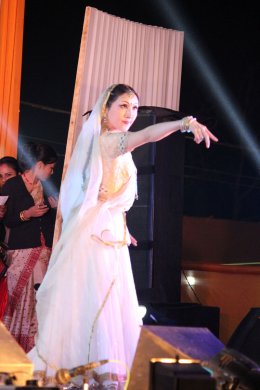 Masako Sato 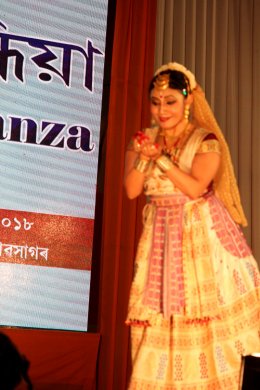 Anwesha Mahanta Sattriya dancer Anwesha Mahanta of Bhangima Kalakendra of Sivasagar, also a resident of the place, struck a rapport with the audience with Shiva Vandana. A student of Guru Jatin Goswami, Anwesha also started with Om Namah Shivaya, continuing with describing Shiva with water of the Ganga flowing down his neck and the snake hanging around his neck like a garland, while he performs his tandava to the beat of his damaru. From bhakti saint Srimant Sankaradeva's Haramohana, Anwesha chose to perform Hari Hara Lila in raag Vasanta, the fascinating story of Shiva's wish to see Vishnu in Mohini rupa. Reluctant Vishnu reiterated that his task to get the Amrit from the asuras to give it to the gods in the garb of Mohini was over and that he would not risk alluring Shiva. Shiva was sure that Mohini would not be able to make a dent on him, because he had already turned the love god Manmatha to ashes. Contrary to Shiva's belief, Mohini does attract him, but Vishnu assures him saying that he and Shiva are one entity. The repentant Shiva realized that he was not free from the beckoning of the physical world. In the intricacies of dance in imitating Mohini's hansa chal, her coyness in Swarga Upavana along with the earth bound and space bound movements of Sattriya dance, one noticed innovations since the dance form's inception on the proscenium stage. Nothing in the world is static or rigid and dance is no exception. New Delhi based Bharatanatyam teacher and choreographer, Justin McCarthy performed Navarasa, and all of the rasas aptly revolved around Shiva. The varnam in ragam Shankarabaranam where the nayika professed her love longings for Lord Brihadeeswara of Tanjavur through perfect renderings of the nritta portions and the miming portions, made a good impact on connoisseurs. His musical support was excellent. Talented vocalist Sudha Raghuraman composed an item in Sindhu Bhairavi showing the different instruments Shiva plays; it was something unique. The creativity of the performer was praiseworthy. 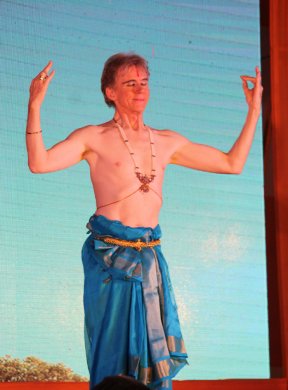 Justin McCarthy 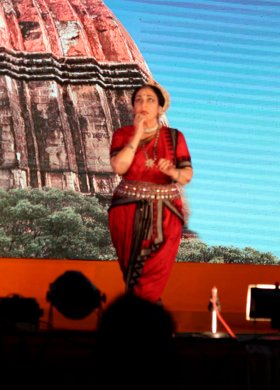 Sharon Lowen Sharon Lowen, a leading Odissi dancer trained by Guru Kelucharan Mohapatra, gave a glimpse of her emotive powers and led the audience to great heights of aesthetic enjoyment with her rendition of Kalidasa's Kumarasambhava delineating the intensity of sringara rasa. It was a joy for all to see the love between Shiva and Parvati. The role of a khandita nayika through an ashtapadi Yahi Madhava Yahi Kesava showing Radha's wrath for her Kesava on seeing love marks on his chest displayed the bhakta's unpreparedness to merge with the lord because of human emotions like ego, which makes her believe that Krishna can only belong to her. It requires sensitivity to portray this angle and Sharon scored high in her interpretation. Viswanath Mangaraj, a disciple of Sharon, performed Shankarabaranam Pallavi with perfection. Both guru and shishya displayed dedication and respect for each other. 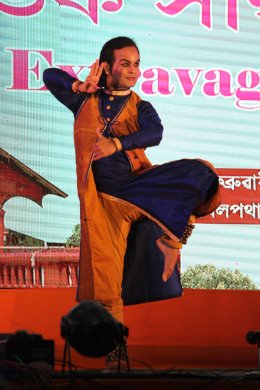
Hemant Kalita
Kathaka Hemant Kalita, a disciple of Birju Maharaj and Munna Shukla, performed a self composed Shiva Stuti, followed by Ananda Tandava. A dancer's mettle and readiness can be tested best through a Shiva tandava. Perfect Shiva poses come to a dancer with a great deal of practice with the guidance of the right guru. His display of the technicalities of Kathak along with showcasing of sixteen beat taal Dhamar showed both power and grace. Sarpa Gati in laya and tihai and Shiva Parvati Kathapkathan along with Lucknow gharana bol and pakhawaj ka bol with the tabla pleased the audience. Gatis of the peacock and the deer, the bees were most enchanting. Shiva Arti rounded off his show. In time to come, it is expected that the festival will attract tourists from other parts of the world for its exotic value. Tapati Chowdurie learnt dance from Guru Gopinath in his dance institution Natana Niketan in Madras. For a brief period, she was with International Centre for Kathakali in New Delhi. Tapati has a Master's degree in English Literature. Presently, she is a freelance writer on the performing arts. |